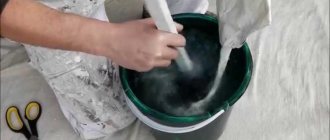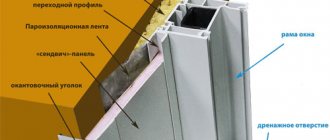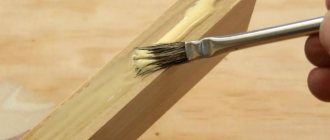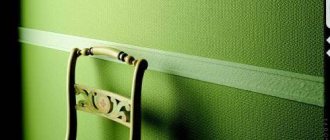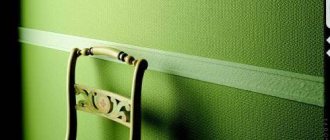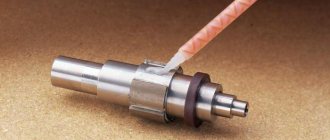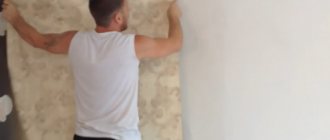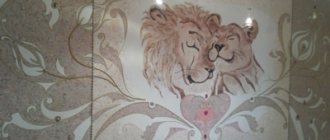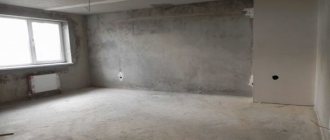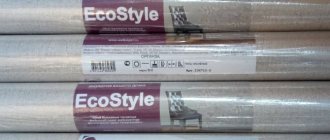It doesn’t matter what wall coverings you use when repairing and finishing your apartment: paper, non-woven, vinyl or acrylic. To glue them you will need special glue. Fortunately, the choice is now huge. Do you want to save money on repairs or are you allergic to glue from the hardware store? We advise you to make your own wallpaper paste. It has no disadvantages, regardless of the method of preparation and composition (flour or starch), but it has many positive qualities:
- low cost of components (the most budget option made from flour or starch is suitable),
- environmentally friendly,
- completely safe for health (even a child can use this adhesive composition), hypoallergenic,
- self-made glue will also save on wall primer by replacing it,
- if it is necessary to remove the wallpaper in the future, it is enough to moisten it with warm water,
- such an adhesive composition does not turn yellow over time and does not leave stains,
- it can be used as an analogue of glue for paper, papier-mâché and even corrugated cardboard.
Do not forget to prepare a sufficient amount of paste for preliminary “priming” of the walls.
Flour paste
Wallpaper paste made from flour is a universal popular product that is suitable for almost any type of wall covering. Whatever method you choose, each will contain water and grade 1 or 2 flour. Sometimes wood glue or PVA glue is also added.
The simplest recipe for wallpaper paste made from flour is simple. It is enough to take flour (the highest or even 1st grade is not needed here, you can limit yourself to 2) at the rate of 2 tablespoons per 1 liter of warm water. Put water on the stove, add flour and cook with constant stirring. For “one serving” 5 minutes of cooking is enough. The recipe is suitable for gluing light wallpaper and gluing paper.
There is a more complex method of preparation. It is recommended to use when using medium and heavy wallpaper. The difference is in proportions.
Mix flour and water in a ratio of 1:3. It is advisable to take warm, but not hot water. This way the flour will dissolve better. Place the container with the mixture on the stove and cook over low heat until it boils, stirring constantly. Now we filter the composition and cool. After cooling, your glue is ready for use.
Flour paste with PVA glue
Now let's talk about how to make a paste from flour for wallpaper with the addition of PVA glue. This will make it resistant to water. Removing wallpaper from the walls will become more difficult, and the maximum weight of the wallpaper will increase. We recommend using it with heavy wall coverings.
Take 200-250 grams of flour and add a little water to it. Do not forget to constantly stir the future glue. The resulting lumps should be broken up or removed. After this, add warm water to the composition, bringing the volume to 1 liter. If the mixture seems too thick, use hot water.
Do not add water immediately to avoid lumps forming. Now take half a cup of PVA glue (or regular wood glue) and pour it into your composition. Stir and continue cooking until bubbles form. If necessary, strain the resulting mixture through a sieve or cheesecloth.
Wait a few minutes for the adhesive to cool. Now you can start working with it. If a film/foam forms on the surface as it cools, remove it.
Surprisingly, when using flour wallpaper glue, you don't have to completely dry the walls. Just use rye flour instead of wheat flour (2 kilograms per 1 liter), and then add hot water to 8-9 liters and 600 g of turpentine.
Paste as an alternative to commercial wallpaper adhesives
It is not at all difficult to make effective and reliable wallpaper adhesive with your own hands without the use of chemical additives or special equipment. The need for a homemade adhesive composition arises in the following situations:
- I've run out of purchased glue. Repair work often drags on until late, when all the stores are already closed, making it impossible to purchase new goods. That's why you have to make the glue yourself. And the process of preparing it takes as much time as going to the store.
- High price of production composition. Reviews from craftsmen who regularly make paste with their own hands directly indicate that with equal volumes of homemade and purchased products, the former is an order of magnitude cheaper.
- Lack of universal glue in the store. In such a situation, choosing the right composition for a specific type of wallpaper is quite difficult. But you can easily add an additional ingredient to the paste you prepare yourself, making the composition ideal for light or heavy wallpaper, as well as other materials.
- The health hazards of purchased products. During the production of industrial adhesives, all sorts of harmful additives are added to them, which in no case should be inhaled for a long time. Homemade paste contains only environmentally friendly components, and besides, the manufacturer knows exactly what he adds to the composition.
Starch paste
Making wallpaper paste from starch is as easy as making paste from flour. This composition is perfect for thin and ultra-thin wallpaper. The recipe is considered more economical than flour paste.
The classic recipe for starch paste for wallpaper is this: take starch and water in a ratio of 1:9. Sift it through a fine sieve. Add water to the prepared starch, remembering to constantly stir the composition. Now place the container on the stove and cook over low heat, stirring constantly. Some experts advise preparing a starch paste in a water bath. The most important thing is good mixing of the components.
If you want to add moisture resistance to the glue, use ½-1 cup of PVA glue.
Don't forget to strain the resulting mixture through a sieve or cheesecloth.
How to cook it yourself: instructions
For initial mixing, you can use any available tool, including a whisk.
So, how to cook wallpaper paste? In this article we will look at the 2 most common recipes. As for the gluing process itself, you can find out more detailed information about this from this article.
We make it using starch
It is this composition that leaves behind the least amount of stains, even with somewhat sloppy gluing. To be more precise, it leaves no stain at all. It is for this reason that they can be used to glue wallpaper of any color: from dark to light tones. So, here are brief instructions on how to prepare it yourself:
- Having bought ordinary starch (this can be done at any store), the first thing you need to do is sift it. As for the volume of the future paste, for each kilogram of composition you will need 100 grams of starch.
- After sifting, you need to add water to the starch, stirring the composition a little. As a result, you should get a substance of uniform consistency that resembles sour cream.
- After preparation, it is necessary to act as quickly as possible, since this glue hardens quite quickly.
- Pour the contents into a metal bowl (use a basin or bucket) and while stirring vigorously, add a small amount of boiling water. After everything is mixed, you can strain the mixture through cheesecloth to sift out any lumps. This will help improve adhesion and avoid bubbles on the wallpaper.
- In addition, the paste can be cooked using the water bath method. During the cooking process, it must be stirred until bubbles appear on the surface. Then turn off the heat and cool the contents of the dish.
Interesting to know! It is entirely acceptable to use paste as a primer when preparing walls for wallpapering. At the same time, it can be diluted with additional water.
PVA paste
This type of adhesive composition is considered the most expensive. But it also surpasses its counterparts in quality. He is not at all afraid of water. After using it, you will have to remove the wallpaper along with the plaster. In addition, the shelf life of such glue is almost unlimited (the main thing is to prevent air from entering the finished composition).
So, dilute the PVA glue with cold (!) water in a ratio of 1:2. Mix thoroughly until you obtain a creamy consistency. Now the paste can be used.
Application, advantages and disadvantages of paste
DIY glue
Paste is understood as an adhesive composition that should be cooked on the basis of starch, flour with the addition of water. All components are available, cheap, and natural. They are not harmful to children and adults, and do not pose a danger to allergy sufferers - even after tasting the glue, the baby will not be poisoned. The paste is suitable not only for wallpaper, it is also widely used for crafts:
- papier mache,
- piñatas (a type of papier-mâché),
- cotton toy,
- children's applications,
- other work with paper, cotton wool, natural materials,
- scrapbooking,
- decoupage,
- products made from threads, fabrics,
- artificial flowers.
Librarians use paste to glue book bindings together. In gardening, strips of paper are smeared with it, sprinkled with seeds, and then placed in the ground. In repair work, the product is used to seal windows and seal cracks in wood. If you dilute the thick glue with water, it makes an excellent primer. As for wallpaper, the solution will perfectly hold even the heaviest coating.
What are the other advantages of gelatinization? Here are the benefits of using homemade glue:
- suitability for different surfaces in the house, even painted, impregnated with drying oil,
- absence of marks on the wallpaper with the correct application technique,
- easy removal of glue stains when used carelessly,
- quick setting and quick drying of canvases on walls,
- long service life - no less than that of store-bought adhesives,
- Easy removal of wallpaper if you need to replace it - you just need to spray the wall with water.
The product has few disadvantages. We can only call it unstable to water, although the addition of some components corrects this problem. Also, thanks to the edible composition, insect pests can settle in the glue, but proper storage eliminates the problem.
Recipe for papier-mâché
You need to take a glass of flour, half a teaspoon of salt and 3 glasses of water. The composition is prepared as follows:
- sifted flour is poured into a glass of water and kneaded until smooth;
- salt is added and kneaded again;
- 2 cups of water are boiled in a separate pan and then added to the adhesive composition;
- The resulting mixture is boiled over a fire for 10 minutes, removed from the stove and left to cool completely.
If making papier-mâché involves using paper soaked to a plastic mass, the paste needs to be made more liquid, then no more than 100 g of flour should be used per liter of water.
How to store?
It will not be possible to store such a natural solution for a long time , otherwise all the adhesive properties of the mixture will gradually deteriorate. If the remaining glue is planned to be used further, it must be poured into a new container with a tight-fitting lid and placed in the refrigerator. The product can be stored in the cold for a maximum of 1 day. Therefore, experts recommend boiling it 2 hours before use and try not to store it for longer than a day.
When the consistency of a too thick mass has already undergone changes (the proportions of water or flour have changed), it has an unpleasant sour smell, the workpiece must be boiled again over low heat, then add a spoonful of alcohol and stir thoroughly until smooth.
Advice
One of the effective recipes for extending the service life of the paste is to prepare it from flour with the addition of carbolic acid (no more than 25 g per 10 liters).
We described how to properly store wallpaper and glue diluted for it in this article.
Savings during renovations sometimes pay off. The homemade equivalent of wallpaper glue, paste, is one of the successful life hacks that have remained relevant for decades. The mixture is safe, easy to prepare and cheap, not to mention the quality is not inferior to store-bought building materials.
Cooking rules and tips
- The finished mixture must be used within the first day after cooking, otherwise it may turn sour.
- An adhesive composition made from rye flour cannot be used when gluing thin wallpaper in light colors, as this is fraught with the appearance of yellow spots appearing over the entire surface.
- To repel parasites and insects from the paste, it is necessary to add karbofos to it during production.
- In order for the paste to lie evenly on the wallpaper and be moderately liquid, you need to avoid overcooking the adhesive mass. If this happens, then in order to make it more liquid, you need to add the required amount of water and heat the composition again. If the paste is too thin, this can be corrected using a thickener.
- In a warm room, the adhesive composition loses its astringent qualities, so it must be stored in a cool place at a temperature not exceeding +18 ... + 20 ° C.
- The preparation of the composition must be done before using it, since its maximum fixing properties are revealed at a mass temperature of +40°C.
- To prepare starch glue, you can use both potato and corn starch, the result does not change.
- If it is necessary to increase the moisture resistance of flour glue, then during its cooking you should add PVA glue, but not less than 5% of the total mass.
